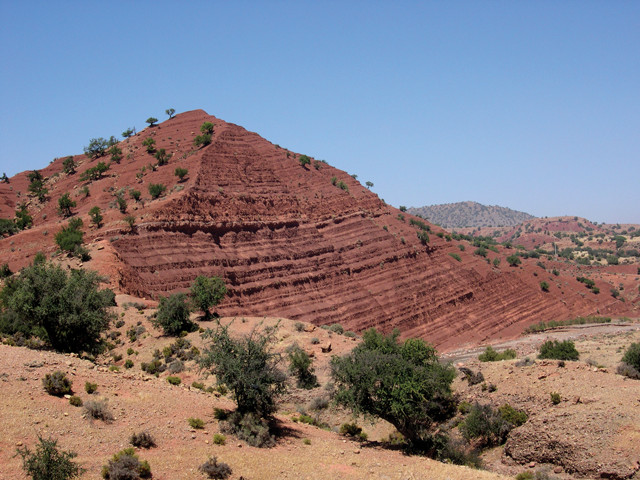
by Lucas Joel Thursday, September 14, 2017

These continental sedimentary layers in Morocco spanning the end-Triassic mass extinction event were analyzed for mercury content in a new study. Credit: Jessica Whiteside.
The end-Triassic mass extinction exterminated up to three-quarters of all species on land and in the oceans 201 million years ago. This die-off opened up ecological niches and allowed for, among other changes, dinosaurs to diversify and spread across terrestrial ecosystems during the rest of the Mesozoic. Volcanism has long been implicated in the extinction, but whether it had a major impact on the planet at the time has remained unclear. In new research, scientists observed elevated mercury concentrations in extinction-aged rocks from around the world. Because volcanism is the main nonanthropogenic source of mercury in the environment, the findings suggest that volcanic activity was likely the main extinction trigger at the end of the Triassic.
“There was a big increase in volcanism happening precisely at the time of this extinction,” says Lawrence Percival, a recent University of Oxford doctoral graduate and lead author of a new study in Proceedings of the National Academy of Sciences. Volcanic rocks dating to around the time of the extinction occur in Africa, Europe and North and South America. These rocks form the Central Atlantic Magmatic Province (CAMP), which covers roughly 7 million square kilometers and which originally erupted as Pangea was splitting and the Atlantic Ocean began forming. The similar timing of the extinction and the CAMP eruptions is well established, “but that on its own doesn’t prove that the volcanism was actually having any impact on the Earth system,” Percival says.
To investigate the extinction trigger, Percival and his co-authors examined six different sedimentary sections — one each in Argentina, Austria, Canada, Greenland, Morocco and the U.K. — that span the extinction boundary. Of those sections, five showed spikes in mercury levels, Percival says, with concentrations increasing by a factor of five.
Within 100,000 to 200,000 years of the first spike seen in the sediments, which coincides with the extinction’s onset, there were at least three additional “pulses” of increased mercury concentrations. “This suggests there was repeated, large-scale volcanism going on,” Percival says. “The big spikes in mercury also match evidence for a big increase in [atmospheric] carbon dioxide,” he says, which “strongly supports that the carbon dioxide increase at this time was volcanically sourced.” This pulsed volcanism likely led to prolonged greenhouse gas-induced climate change, Percival explains, which would have made it harder for life to survive during the extinction.
The new study offers “quite a comprehensive investigation of mercury excursions associated with the end-Triassic mass extinction,” says Alyson Thibodeau, a geochemist at Dickinson College in Carlisle, Pa., who was not involved in the work. “It was interesting that they looked not only at marine sections, but also at terrestrial aquatic environments.” Thibodeau says that finding the mercury spikes in both types of environments implies that the source of the mercury was “not just some sort of environmental perturbation that’s related to the ocean” alone, but that it was likely widely deposited from the atmosphere. That strengthens the case that it is volcanic in origin because it means the mercury occurred as a gas.
Also, because the mercury spike occurs in marine sections, the CAMP eruptions must have been large enough to impact areas far from where the lava actually flowed, says Paul Olsen, a paleontologist at Columbia University who was not involved in the study. The fact that the eruption signal reached the marine realm “is especially important,” Olsen says, because it also enables researchers to tie the marine extinctions to the eruptions.
The end-Triassic is not the only extinction event associated with sedimentary mercury spikes. For instance, mercury spikes potentially related to volcanism also correspond with the timing of the end-Ordovician extinction, Percival notes. He says the next task is to see if such mercury anomalies align with other extinctions as well.
© 2008-2021. All rights reserved. Any copying, redistribution or retransmission of any of the contents of this service without the expressed written permission of the American Geosciences Institute is expressly prohibited. Click here for all copyright requests.